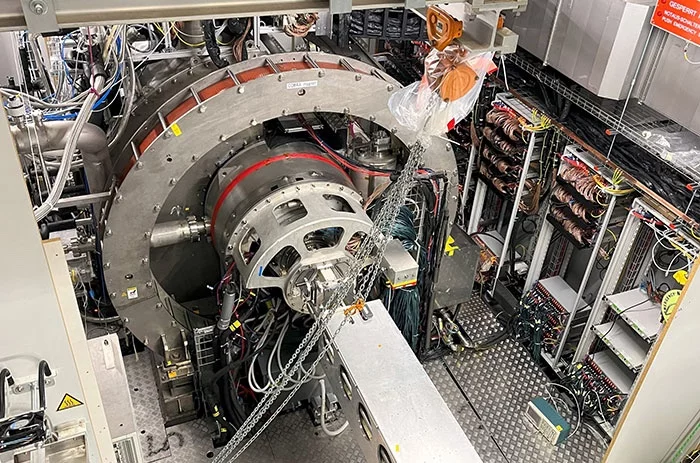On the occasion of a special seminar at the Paul Scherrer Institut (PSI) in Switzerland on 23 April 2024 the scientific collaboration of the MEG II experiment presented an important new result in the search for the decay of a positive muon into a positron and a photon.
The findings, based on data collected in 2021 and 2022, are detailed in a paper published on arXiv and submitted to the journal Physical Review Letters.
The data analysis did not reveal any significant excess of events over the expected background. A new upper limit on the probability of this process has thus been established, which now stands as the most stringent limit in the world. This result updates and improves upon the previous best limit, which was obtained by combining data from the earlier MEG experiment with those from 2021 of MEG II and presented in 2023. The improvement is mainly due to the larger dataset collected in 2022, which is four times larger than that of 2021 alone, and represents the first measurement based entirely on MEG II data.
The decay under Investigation, never observed to date, has been the focus of many experimental efforts over the years. Its potential discovery would provide clear evidence of physics beyond the Standard Model of Particle Physics, opening the door to a completely new horizon.
In the MEG II experiment, muons from the world’s most intense continuous muon beam are stopped on a thin target placed at the center of a superconducting magnet. The decay products are tracked using beyond state-of-the-art detectors: an ultralight gas drift chamber and an array of plastic scintillator tiles are used to reconstruct the positron’s trajectory and time of flight, while photons are detected with a 900-liter liquid xenon calorimeter.
MEG II continued data taking during 2023 and 2024 and will proceed through 2025–2026. The final dataset of MEG II is expected to be about five times larger than the one presented today. The goal is to improve the sensitivity to this decay by an order of magnitude compared to its predecessor, MEG.
The MEG II collaboration includes almost 70 physicists from research institutions from five countries. Researchers and technicians from PSI have played a leading role, particularly with providing the high-quality beam, technical support in the detector integration, and in the design, construction, and operation of the detector readout electronics.
Contact:
Dr. Stefan Ritt
Laboratory for Particle Physics (LTP)
Paul Scherrer Institute, Forschungsstrasse 111, 5232 Villigen PSI, Switzerland
Telephone: +41 56 310 3728
Email: stefan.ritt@psi.ch
Text based on media release by INFN, Italy


